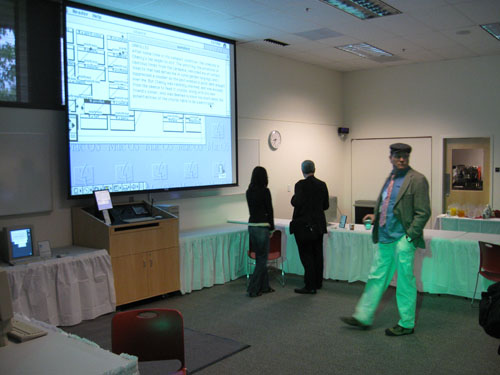An inspirational gathering for lovers of electronic literature
Electronic Literature, Events,
6/18/08
I’ve had peripheral contact with the Electronic Literature Organization over the years (including a public reading of unpublished chapters of Chroma at the Hammer Museum which was a blast), but never attended one of their conferences until this year. Blue Velvet was accepted in to the Media Art Show at this year’s Visionary Landscapes conference at Washington State University Vancouver, which afforded me the opportunity to attend. I’m glad I did—it was a wonderful experience.

The ‘Early Authors of Electronic Literature’ exhibit at the Visionary Landscapes conference.
Having so many luminaries in the field in one place was enlightening in and of itself, especially because the attendees were a mix of both scholars and artists, making for a lively interplay between theory and practice. In many cases, I ended up meeting people for the first time whose names I’ve been aware of for years. Gratifying as well was the chance to connect with a number of folks who were early fans of The Lair of the Marrow Monkey and Chroma. New faces were abundant as well—people excited by the potential of the medium who were either taking their first steps in this world or doing important research to push the form ahead.
I was particularly impressed by the work being done in generative narrative by D. Fox Harrell, Kenny K. N. Chow and Jichen Zhu at Georgia Tech. The GRIOT system originated by Harrell and Joseph Goguen takes what I found to be a very refreshing approach to dynamic narrative—I can’t say that I have a strong grasp of the technical aspects of the engine, but there was a kind of fluidity of scale and affect involved in the formal elements the system generates that felt far less “brittle” than other generative approaches I’m familiar with. The fact that GRIOT immediately appeared in my mind to be well-suited to cinema, poetry and comics simultaneously was an intuitive whisper for me that Harrell and his collaborators are moving in a very productive direction.
The recent release of the Electronic Literature Collection: Volume One also seemed to mark a milestone for the field, being the first of a proposed series of collections of seminal e-lit works. Each volume is published on DVD and online under a Creative Commons license to encourage the widest dispersal possible. The conference at times felt like an implicit celebration that e-lit has managed to survive long enough to make such collections possible. While the boundaries defining exactly what e-lit is remain porous and will rightly continue to be so, the fact that a gathering dedicated to the field could engender the sense of cameraderie that it did is certainly something to celebrate. Thanks to Dene Grigar and John Barber for putting on such a great event.
Recent Posts
Go InSight: Composing a Musical Summation of Every Mission to Mars (Part 2)
Making music out of the data of interplanetary exploration.
Go InSight: Composing a musical summation of every mission to Mars (Part 1)
Making music out of the data of interplanetary exploration.
Cited Works from “Storytelling in the Age of Divided Screens”
Here’s a list of links to works cited in my recent talk “Storytelling in the Age of Divided Screens” at Gallaudet University.
Timeframing: The Art of Comics on Screens
I’m very happy to announce the launch of “Timeframing: The Art of Comics on Screens,” a new website that explores what comics have to teach us about creative communication in the age of screen media.
The prototype that led to Upgrade Soul
To celebrate the launch of Upgrade Soul, here’s a screen shot of an eleven year old prototype I made that sets artwork from Will Eisner’s “The Treasure of Avenue ‘C’” (a story from New York: The Big City) in two dynamically resizable panels.
Categories
Algorithms
Animation
Announcements
Authoring Tools
Comics
Digital Humanities
Electronic Literature
Events
Experiments
Exemplary Work
Flash
Flex
Fun
Games
Graphic Design
Interactive Design
iPhone
jQuery
LA Flash
Miscellaneous
Music
Opertoon
Remembrances
Source Code
Typography
User Experience
Viewfinder
Wii
Archives
July 2018
May 2018
February 2015
October 2014
October 2012
February 2012
January 2012
January 2011
April 2010
March 2010
October 2009
February 2009
January 2009
December 2008
September 2008
July 2008
June 2008
April 2008
March 2008
February 2008
January 2008
November 2007
October 2007
September 2007
August 2007
July 2007
June 2007